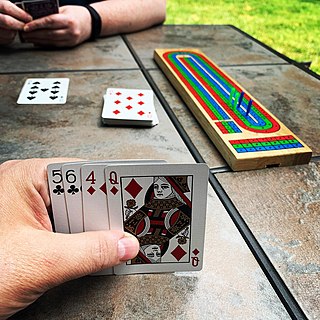
Cribbage, or crib, is a card game, traditionally for two players, that involves playing and grouping cards in combinations which gain points. It can be adapted for three or four players.
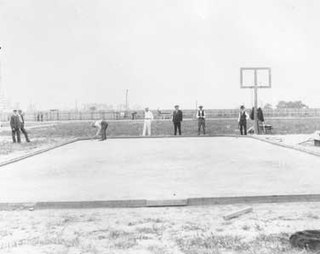
Roque is an American variant of croquet played on a hard, smooth surface. Popular in the first quarter of the 20th century and billed "the Game of the Century" by its enthusiasts, it was an Olympic sport in the 1904 Summer Games, replacing croquet from the previous games.
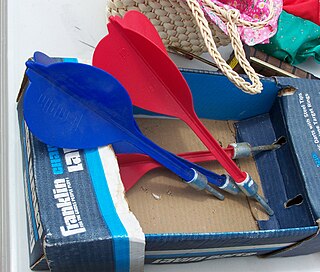
Lawn darts is a lawn game for two players or teams. A lawn dart set usually includes four large darts and two targets. The game play and objective are similar to those of both horseshoes and darts. The darts are typically 12 inches (30 cm) in length with a weighted metal or plastic tip on one end and three plastic fins on a rod at the other end. The darts are intended to be tossed underhand toward a horizontal ground target, where the weighted end hits first and sticks into the ground. The target is typically a plastic ring, and landing anywhere within the ring scores a point.

Beer die, beer dye or snappa is a table-based drinking game in which opposing players sit or stand at opposite ends and throw a die over a certain height with the goal of either landing the die in their opponent's cup or having the die hit the table and bounce over the scoring area to the floor. The defending team attempts to catch the die one-handed after it hits the table, but before it touches a non-table surface. The game typically consists of two two-player teams with each of the four players having a designated cup on the table, but can also be played one-vs-one.

Quoits is a traditional game which involves the throwing of metal, rope or rubber rings over a set distance, usually to land over or near a spike. The game of quoits encompasses several distinct variations.
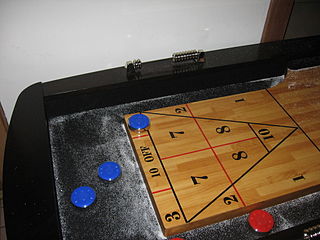
Table shuffleboard is a game in which players push metal-and-plastic weighted pucks down a long and smooth wooden table into a scoring area at the opposite end of the table. Shooting is performed with the hand directly, as opposed to deck shuffleboard's use of cue sticks.
Propataireachd – there were two games in Uist, Scotland called by this name.

A lawn game is an outdoor game that can be played on a lawn. Many types and variations of lawn games exist, which includes games that use balls and the throwing of objects as their primary means of gameplay. Some lawn games are historical in nature, having been devised and played in different forms for centuries. Some lawn games are traditionally played on a pitch. Some companies produce and market lawn games for home use in a front or backyard.
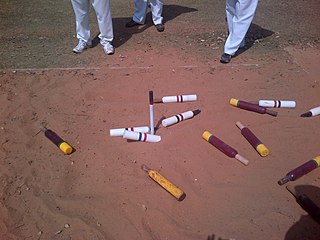
Jukskei is a 280-year-old folk sport developed and played in South Africa.

Washer pitching is a game, similar to horseshoes, that involves teams of players that take turns tossing washers towards a box or hole. The game has many variations, and may be called washer pitching, washer toss, washers, huachas or washoes.

Cornhole is a lawn game popular in North America in which players or teams take turns throwing fabric bean bags at a raised, angled board with a hole in its far end. The goal of the game is to score points by either landing a bag on the board or putting a bag through the hole.

Polish horseshoes is an outdoor game played between two teams of two people using a frisbee, two glass bottles or cans, and stakes, ski poles or hiking sticks hammered into the ground. The game is played by the players taking turns throwing a frisbee at a glass bottle that rests on top of the stakes in the ground. The two stakes are placed anywhere between 20 and 40 ft apart. Players must hold a drink in one hand at all times, leaving only one hand free for throwing and catching.

Ladder toss is a lawn game played by throwing bolas onto a ladder.

A footbag is a small, round bag usually filled with plastic pellets or sand, which is kicked into the air as part of a competitive game or as a display of dexterity. "Hacky Sack" is the name of a brand of footbag popular in the 1970s, which has since become a generic trademark.

Fowling is a hybrid game that combines the equipment of American football and bowling into one sport with a similar layout as horseshoes and cornhole. Most commonly played as a pastime in a tailgate or campground setting across the United States, Fowling was founded in 2001 by Chris Hutt and a bunch of friends from Detroit, Michigan, tailgating at the Indy 500. The object of Fowling is for teams to be the first to knock down all opponent's pins by throwing a full-size regulation football at 10 bowling pins positioned in a traditional bowling layout.

Muckers, also known as ring toss or circle horseshoes, is an outdoor game, commonly played at summer camps, in which players take turns throwing circular rings at a stick, standing about one foot high. It is a spin-off of Quoits and the popular horseshoes.

Throwing sports, or throwing games, are physical, human competitions where the outcome is measured by a player's ability to throw an object.

Trictrac is a French board game of skill and chance for two players that is played with dice on a game board similar, but not identical, to that of backgammon. It was "the classic tables game" of France in the way that backgammon is in the English-speaking world.

Rolle Bolle, also known as Belgian Bowling or Krulbollen, is a bowling sport related to boules, and originates from the Flanders region of Belgium. The sport was introduced to North America in the late 19th and early 20th centuries and is played in some rural areas of the Midwest and Prairie regions of the United States and Canada.
The White House horseshoe pit is a horseshoe pit on the South Lawn of the White House, the official residence of the president of the United States. It was established by President Harry Truman and later rebuilt by George H. W. Bush.

























